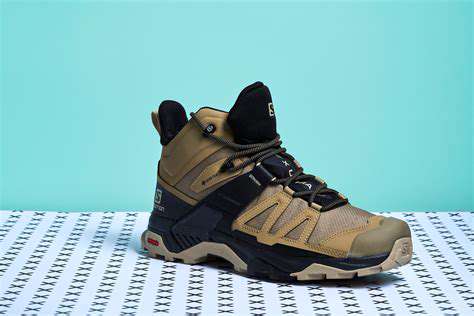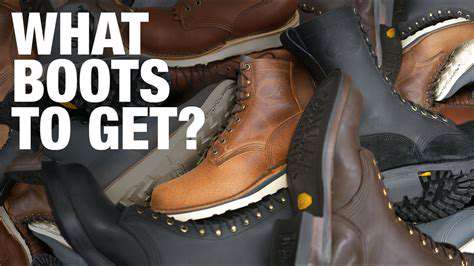Best Hiking Boots for Long Treks [Review]
Durability and Construction
Trail-tested boots need battle-ready materials. Full-grain leather offers legendary toughness, while modern synthetics provide lighter weight with impressive resilience. Inspect the triple-stitched stress points and reinforced toe caps—these areas take the most punishment. The outsole should look aggressive, with multidirectional lugs that bite into loose terrain like a mountain goat's hoof.
Breathability and Moisture Management
Imagine wrapping your feet in plastic bags for eight hours—that's what poor ventilation feels like. Modern boots solve this with strategic mesh panels and moisture-wicking linings that work like athletic wear for your feet. Waterproof membranes (like Gore-Tex) create a breathable forcefield against morning dew and surprise showers, while antimicrobial treatments prevent funky odors from setting up camp in your boots.
Weight and Comfort
Every extra ounce gets heavier with each mile. The sweet spot balances protection with agility—typically 2-3 pounds per pair for serious trekking. Cushioning should cradle your foot without feeling mushy, with arch support tailored to your gait. Test boots in the afternoon when feet naturally swell, and remember: no amount of breaking in will fix fundamentally uncomfortable footwear.
Sole Design and Traction
The best soles combine sticky rubber compounds with intelligent tread patterns. Look for varied lug depths that shed mud while providing flat-surface stability. Vibram's Megagrip compound has become the gold standard, offering tenacious grip on wet rocks where lesser soles would send you sliding. For snowy conditions, some boots accommodate removable crampons for ice security.
Protection from the Elements
Weatherproof boots act like a personal forcefield. Gaiters-integrated designs keep out trail debris, while insulated versions use advanced materials like PrimaLoft to trap warmth without bulk. The most protective models feature rubber toe bumpers and abrasion-resistant panels where brush and scree attack most fiercely.
Break-in Period and Maintenance
Start conditioning new boots with neighborhood walks before committing to backcountry miles. Proper care extends boot life dramatically—clean after muddy hikes and reapply waterproofing before storage. Rotate between two pairs if hiking daily to allow proper drying. Watch for sole separation or compressed cushioning, as worn-out boots lose their protective magic.
Top-Rated Hiking Boot Brands & Models
Best Overall: Salomon X Ultra 4
Salomon's flagship hiker delivers a near-perfect balance of agility and support. The Advanced Chassis system creates responsive stability that adapts to uneven terrain like a second skin. Hikers praise the immediate comfort—no blister-inducing break-in required. The SensiFit construction cradles the foot securely without pressure points, while the Contagrip outsole bites into loose scree with confidence-inspiring tenacity.
Premium Choice: La Sportiva Trango Tech
For technical terrain where every foothold matters, La Sportiva's mountaineering heritage shines. The sticky FriXion rubber sole grips like a gecko's foot on granite slabs, while the torsion-resistant shank provides edging precision. The asymmetric lacing system eliminates hot spots, and the abrasion-resistant upper laughs at sharp rocks. These boots excel where others falter—on exposed ridges and alpine scrambles where security trumps all.
Budget-Friendly Option: Merrell Moab 2
The outdoor industry's best-selling boot for good reason. Merrell's air-cushioned heel absorbs impacts surprisingly well for the price, while the Vibram outsole handles moderate trails competently. The breathable mesh upper keeps summer hikers comfortable, though serious backpackers may want more ankle support. For entry-level hikers or occasional use, the Moab delivers exceptional value without cutting critical corners.
Trail-Specific Model: Hoka Speedgoat 5
Hoka's maximalist cushioning revolution meets trail toughness. The oversized midsole eats up rocky descents like a suspension system, while the Vibram Megagrip outsole claws into loose dirt. The meta-rocker geometry propels you forward effortlessly, making these favorites for fastpackers covering big miles. The wide toe box accommodates swelling feet on multi-day trips, though the high stack height requires adjustment for technical terrain.
Women's Specific Design: Salomon X Ultra 4
While not gender-exclusive, Salomon's last (shoe form) accommodates narrower heels and higher arches common in women's feet. The women's version features slightly softer midsoles and more flexible uppers to match typical biomechanics. Female thru-hikers particularly appreciate the precise heel lock that prevents blisters during long descents. The color options don't sacrifice performance for aesthetics—these are serious tools for serious hikers.






![How to Pack a Carry On Only [Minimalist Guide]](/static/images/27/2025-05/AccessoriesandDocuments3AKeepingitCompactandOrganized.jpg)



![Family Travel Itinerary Ideas [Worldwide Destinations]](/static/images/27/2025-05/ExoticAsianExplorations3AAncientWondersandVibrantCultures.jpg)


